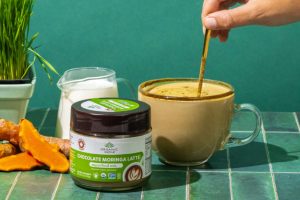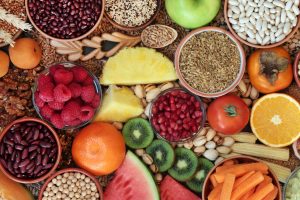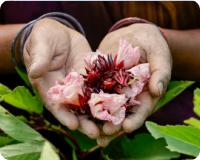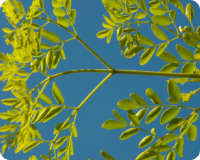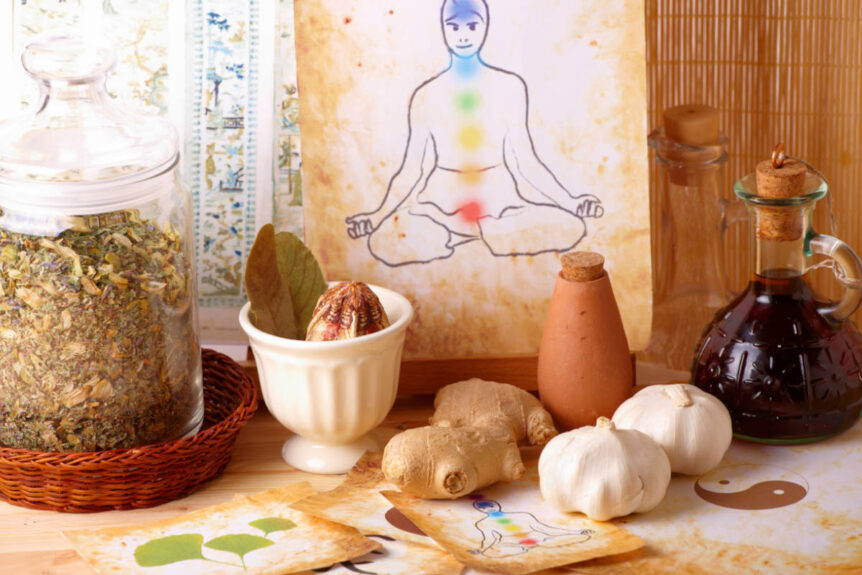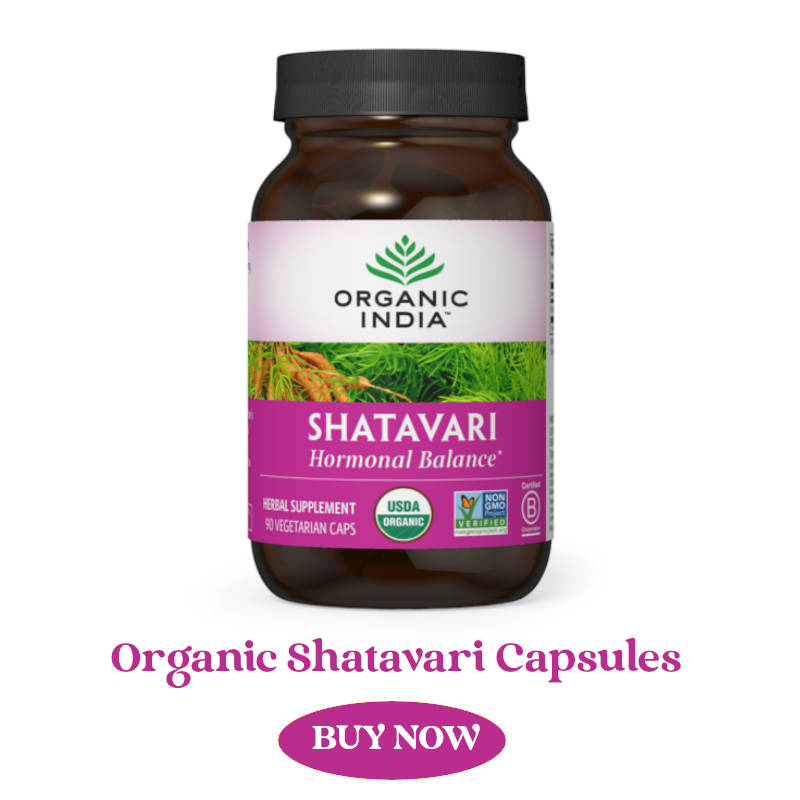

Section

Back
You’ve heard of yoga, meditation and sound healing to realign your chakras, but what about herbs for the chakras? Herbs have been a central part of chakra healing and balancing for centuries. Herbs are an ancient, organic way for humans to connect directly with the vibration of the earth, and utilize powerful roots, petals, leaves, and stems to balance the spiritual and energetic centers of one’s being.
Contents:
- What are chakras?
- What happens when chakras are out of balance?
- The chakra-herb connection
- Herbs for the Chakras
What are chakras?
Chakras are spinning disks of subtle energy located throughout the spiritual body. There are 7 major chakras, but as many as 114 chakras have been identified. The 7 major chakras span from the base of the spine to the crown of the head. They are correlated with different organs and glands, and can influence spiritual, emotional, mental and physical wellness.
The word chakra (traditionally spelt cakra) was first mentioned more than 3,000 years ago in the Vedas – the most ancient of Hindu Scriptures. The word literally translates from Sanskrit to Wheel, and they are understood to be spinning energy vortexes in your spiritual energy field that, when balanced, spin freely and vibrantly in a clockwise direction.

What happens when chakras are out of balance?
When the chakras are out of balance, energy in the body becomes stagnated, which can lead to a slew of physical, emotional and spiritual issues. One may experience lethargy, headaches, muscle stiffness, stress, immune ailments, stifled creativity, moodiness, mental fog and much more. Over time, energy blockage can result in chronic issues like anxiety and various illnesses. Luckily, often when that root imbalance is addressed and the energy is freed, it can help restore health and harmony in the body and mind.*
The chakra-herb connection
Herbs have played a central role in chakra balancing for centuries. Herbs themselves contain bioactives and prana (life force), that work powerfully not only on the physical body, but the spiritual body as well. Herbs, full of life, have access to those subtle energies and therefore are utilized by traditional healers in oils, capsules, teas, tinctures and salves. They are typically recommended by holistic practitioners alongside different lifestyle shifts, yoga postures, energy therapies, breathing techniques and meditative practices.
Herbs for the chakras
Herbs work on both a vibrational and scientific level, bestowing both seen and unseen benefits. They can help enhance your vibration and frequency, which is an amazing start to propel any healing journey. If you think of times you’ve sipped organic herbal tea, or even times you’ve smelt herbs as you walk through a wild meadow, you know the instant harmonizing effects herbs bring to the human system. It’s a love story as old as time.
Learn about herbs to help clear and activate each chakra, starting at the base of the spine all the way through to the crown of the head.
Herbs for the root chakra
The root chakra, as you can imagine, is all about grounding, finding your roots and reclaiming your power. As such, roots like ashwagandha, ginger, turmeric and dandelion are choice herbs for the root chakra and can help you find that internal fire, confidence, and sense of safety and security at the foundational level.
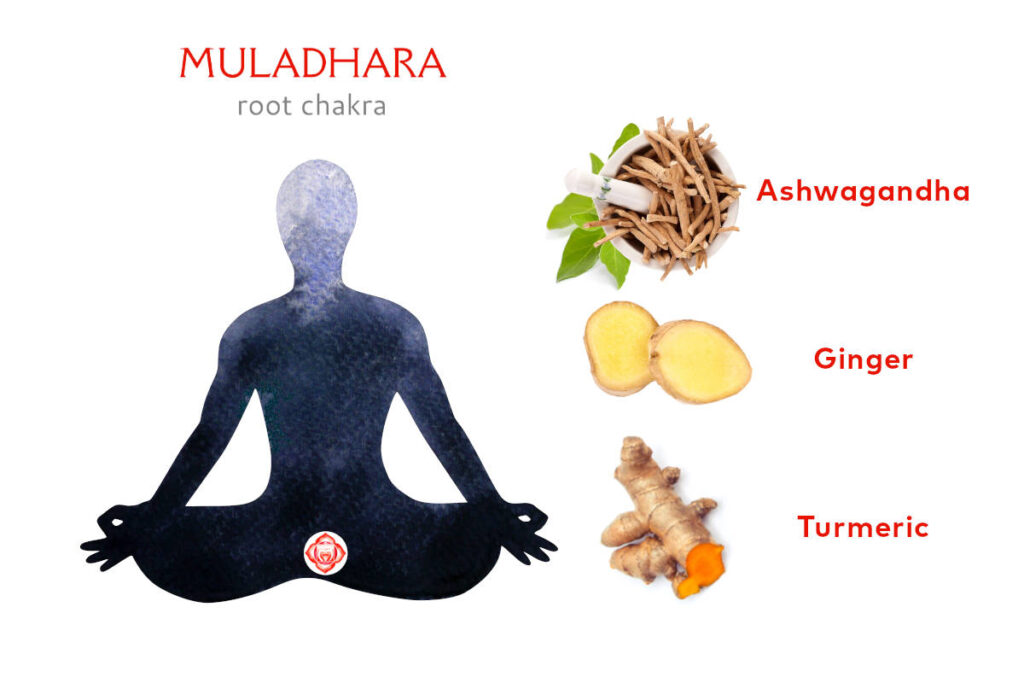
Qualities of the root chakra:
- First chakra: Root chakra
- Sanskrit name: Muladhara
- Location: Base of the spine
- Color: Red
- Herbs: Ashwagandha root, ginger root, turmeric root, dandelion root
- Element: Earth
- Yoga pose: Malasana, or Garland Pose
- Lifestyle Tip: Regular walks in nature, time beneath the trees and “earthing,” or walking barefoot on the grass.
- Spiritual Meaning: Muladhara represents your intrinsic survival instinct, and feelings of security and power. It correlates with groundedness, trust in oneself, and the ability to respond to challenges with confidence and ease.
- Signs of imbalance: Low energy and fatigue, gastrointestinal discomfort, lower body pain
Top 3 herbs for the root chakra
These potent root herbs cleanse and balance the root chakra, while imparting other important benefits for whole system wellness.
Ashwagandha for root chakra.
One of the signs of a root chakra out of balance is both difficulty sleeping and lack of energy. Ashwagandha is a powerful adaptogenic root that relieves stress, while supporting endurance and reproductive wellness. This balancing effect brings about better rest and sustained energy in all areas of life.
How to use
Try Tulsi Ashwagandha tea in the morning and an ashwagandha supplement in the afternoon with lunch while your root chakra is out of balance.
Ginger for root chakra.
Another sign of an imbalanced muladhara is digestive and gastrointestinal issues and discomfort. Ginger has been regarded for millenia for its ability to warm and soothe digestion and relieve blockage in the gastrointestinal tract.
How to use
Tulsi Lemon Ginger tea to brighten your mornings and Tulsi Turmeric Ginger in the evenings to ground you back in. You can also steep fresh ginger with the infusion and strain before serving.*
Turmeric for root chakra.
In addition, a blocked root chakra may manifest as physical pain in the lower back, legs, knees and feet. Turmeric, a highly popular herbal remedy worldwide, supports a healthy inflammatory response to help provide temporary, mild pain relief and ease of mobility.
How to use
Take Turmeric Formula in the morning to ramp up for a day of movement at night to restore from the day’s activities.*
Herbs for the sacral chakra
The sacral chakra is all about intuition, sexuality and creative freedom from anything holding you back – be it a person, circumstance or your own internal fears. Herbs that help you tap into your sensual and expressive side include shatavari, hibiscus, cinnamon and damiana.
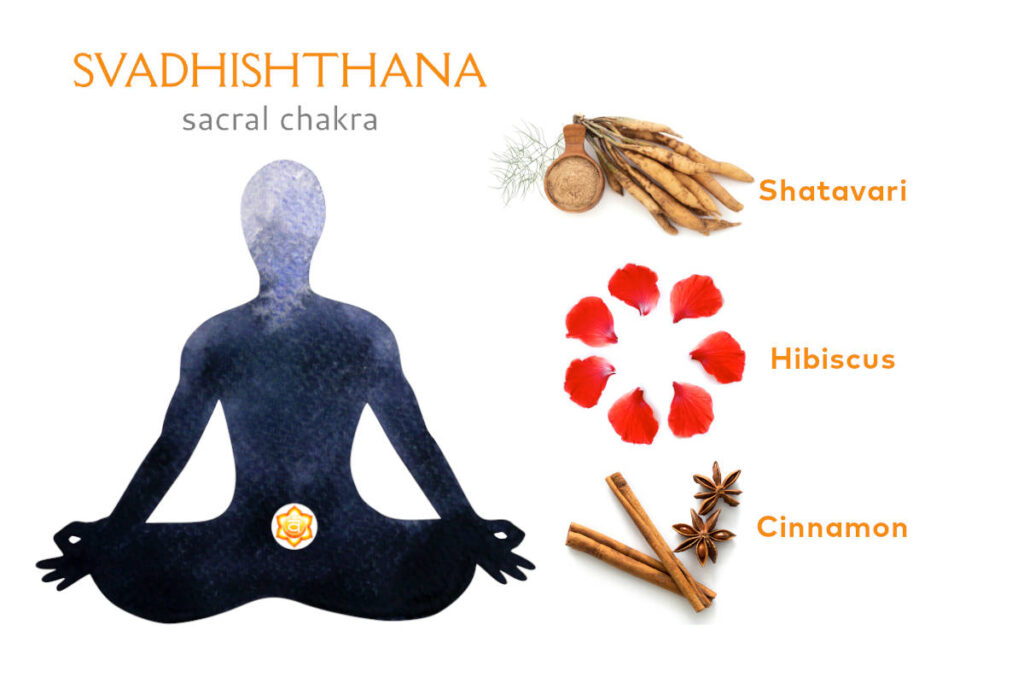
Qualities of the sacral chakra
- Second chakra: Sacral chakra
- Sanskrit Name: Svadhisthana
- Location: Lower abdomen
- Color: Orange
- Herbs: Shatavari, hibiscus, cinnamon, damiana
- Element: Water
- Yoga pose: Utkata Konasana, or Goddess Pose
- Lifestyle tip: Use aromatherapy (essential oil diffuser or incense) to open your senses, connect with the ocean or rivers, and practice stream of consciousness journaling.
- Spiritual meaning: Svadhisthana represents pleasure, passion and overall enjoyment in life. It’s a bright, creative energy center that, when flowing freely, puts you in touch with your artistic essence and the divine feminine.
- Signs of imbalance: Mood swings, fear and worry, repressed sexual energy
Top 3 herbs for the sacral chakra
These balancing and awakening petals, barks and roots can help cleanse your sacral chakra, release fears and ignite creative expression.
Shatavari for sacral chakra
Mood swings are one of the side effects of an imbalanced sacral chakra, which can have you feeling down and irritable. Shatavari is the quintessential herb for hormonal balance, as well as reproductive wellness. It is especially helpful for supporting women through all cycles and stages of life, from menstruation to menopause – and can provide energetic balance.
How to use
Shatavari can be taken twice a day before lunch and before dinner, or you can take Essential Female supplement in the morning, which is a multi-herbal containing shatavari plus tulsi and guduchi for full-spectrum mind, body support.*
Hibiscus for sacral chakra
Worry tends to manifest a lot when the second chakra is blocked, bringing that all-too-familiar feeling of your stomach being in knots – but have no fear! Hibiscus petals unfurl and connect with the orange glow of Svadhisthana to relieve stress, calm the mind, and help you break free from bondage into your wildly creative, free and vibrant self.
How to use:
Have a pack of Tulsi Hibiscus tea on you during those times when you are feeling restless or nervous about something. Steep in hot water and sip mindfully, allowing feelings of courage fill your lower abdomen.*
Cinnamon for sacral chakra
Repressed sensual energy is another outcome that can occur when the 2nd chakra is blocked or dimmed. Ceylon cinnamon, that fiery bark that you know and love, can prove helpful to balance hormones, support healthy circulation in the reproductive system and uplift energy, so you can feel spicy and expressed.
How to use:
Take a Ceylon Cinnamon supplement in the morning to free up stagnated energy in the sacral chakra, and sip Tulsi Cinnamon Rose tea for an extra boost of spice when you need it.*
Herbs for the Solar Plexus Chakra
The solar plexus is like your inner sun, nurturing you from the inside out and beckoning your inner child to come out to play. It’s the part of you that holds enthusiasm and vigor for life, leading with light and optimism. As such, you can awaken this energy center with bright herbs like lemongrass, peppermint, chamomile and goldenrod.
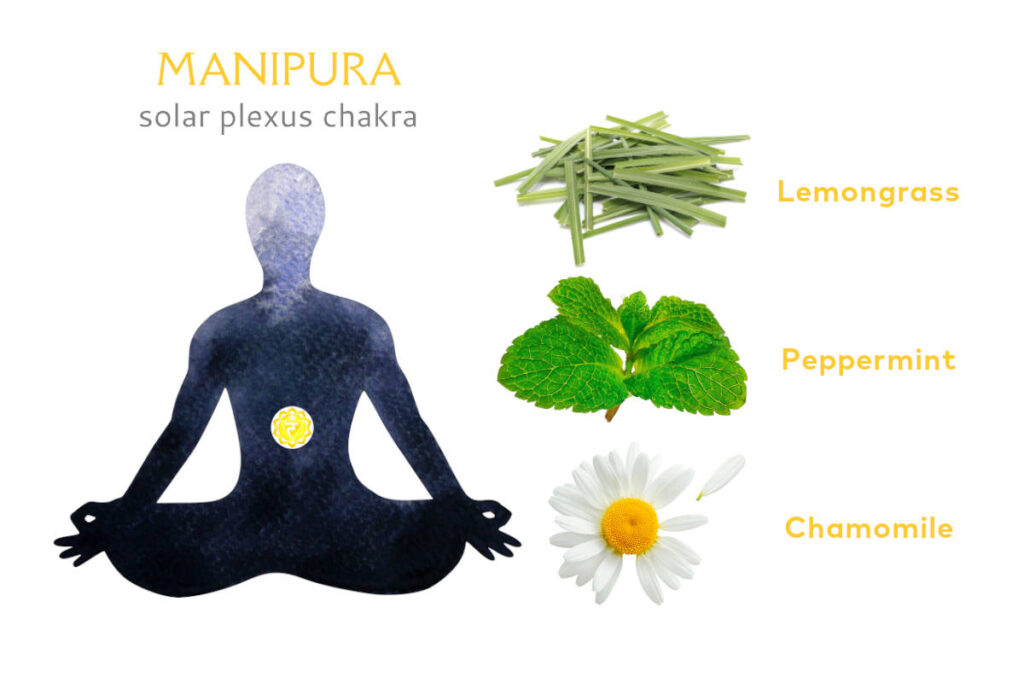
Qualities of the solar plexus chakra
- Third chakra: Solar plexus chakra
- Sanskrit Name: Manipura
- Location: Upper abdomen
- Color: Yellow
- Herbs: Lemongrass, peppermint, chamomile and goldenrod.
- Element: Fire
- Yoga pose: Dhanurasana, or Bow Pose
- Lifestyle tip: Walk outside during the day for at least 20-30 minutes per day, work with yellow crystals like citrine, and gaze at candle flame or bonfire.
- Spiritual meaning: Manipura translates from Sanskrit to “city of jewels,” and represents the sun. The energy is associated with the ego, as well as one’s sense of self worth and willpower, and relates to how a person approaches opportunities in life.
- Signs of imbalance: Low self esteem, digestive issues, irritability
Top 3 herbs for the solar plexus chakra
These 3 bright and awakening herbs can help ignite your inner sun – helping you be the light you wish to be in this world with their ability to help clear self doubt and anger.
Lemongrass for solar plexus chakra
One of the signs of an out of balance 3rd chakra are feelings of low self-esteem, negative self image and general feeling of lackluster for life. Lemongrass is an awakening scent that can uplift one’s spirit, relieve stress and fortify spiritual strength – helping restore feelings of positivity and self-love.
How to use:
A cup of Tulsi Lemon Ginger tea, which contains organic Lemongrass, can be sipped whenever you need some sunshine in your life.*
Peppermint for solar plexus chakra
When the inner sun and fire of Manipura is dulled, it may contribute to sluggish or blocked digestion. The minty cool sensation of peppermint can help relax the muscles of the digestive tract and soothe the stomach to assist with healthy elimination. This can help you feel light and allow your agni, or digestive fire, to work its magic, helping restore solar balance.
How to use
Peppermint tea can be enjoyed any time of day and is especially effective for aiding digestion after meals or whenever you feel discomfort in the digestive tract.*
Chamomile for solar plexus chakra

Tension, irritability and anger may be emotional manifestations of a suppressed solar plexus chakra. Luckily, a sunny little blossom lovingly known as chamomile can be infused into tea to help bring a sense of calm to the mind, so you can relieve stress, relax into the moment, and transform irritability into patience and positivity.
How to use
Enjoy a delicious cup of Tulsi Honey Chamomile tea 45 minutes before bed to ease your mind and bring deep relaxation for a good night’s rest; contributing to a calmer, clearer day to follow.*
Herbs for the Heart Chakra
The one and only heart center is, you guessed it, all about love. Self love, love for others, empathy, compassion and all of those other kind forces that make the world go round. The ultimate herb of the heart is rose, but green herbs like moringa, neem and rosemary can also help unfurl inexpressible joy and peace in the heart.
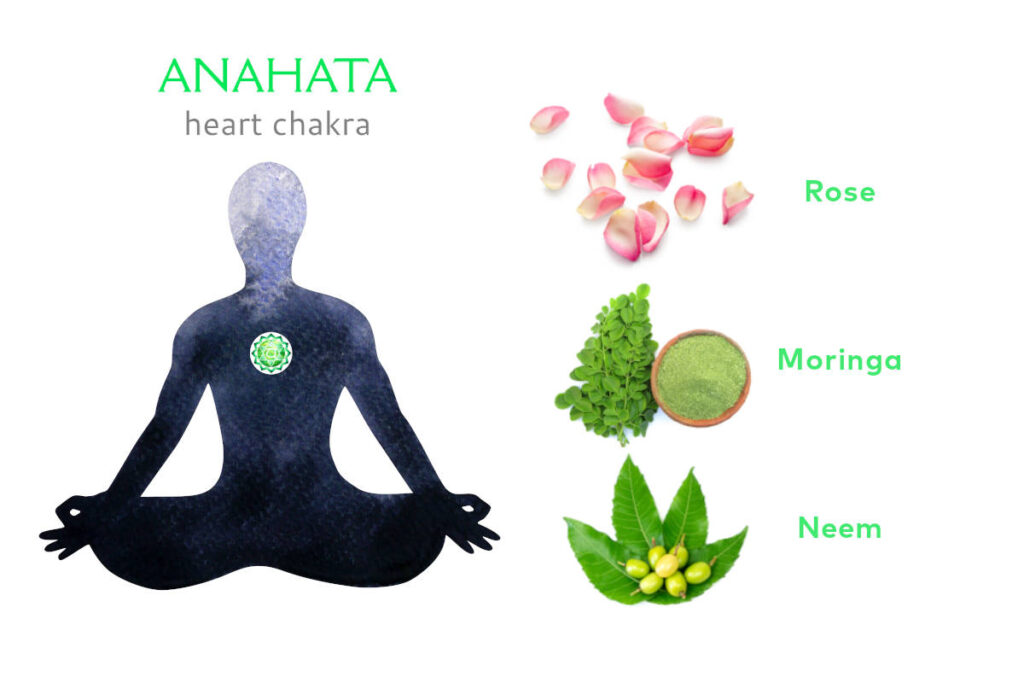
Qualities of the heart chakra
- Fourth chakra: Heart chakra
- Sanskrit Name: Anahata
- Location: Center of chest
- Color: Green
- Herbs: Rose, moringa, neem, rosemary
- Element: Air
- Yoga pose: Natarajasana (Dancers Pose)
- Lifestyle tip: Verbal affirmations, working with rose quartz crystal, hug a loved one
- Spiritual meaning: Anahata is the chakra of unconditional love, for others, for oneself, and for the planet, and is a protective gateway to the spirit. It is the epicenter of profound empathy, honesty and truth, and is the wellspring of good deeds and generosity.
- Signs of imbalance: Poor circulation, feelings of animosity, jealousy, and a lack of self love and compassion.
Top 3 herbs for the heart chakra
One beloved flower and two powerful green herbs bring comprehensive energetic support to the heart center, for a growing radius of love from the inside out.
Rose for heart chakra
A blocked heart center can manifest feelings of animosity, bitterness, jealousy, envy and lack of self love. This high vibrational blossom beholds multisensory benefits that can help lift you out of these unpleasant emotions into forgiveness, compassion and understanding. The taste, aroma and even the sight of a rose elicits a sense of subtle euphoria that carries you back into love.
How to use:
Sip Tulsi Sweet Rose tea any time of day or night to open the heart with its subtly sweet, perfectly balanced rose aura and base of stress-relieving Tulsi to keep the heart at ease.*
Moringa for heart chakra
Tension can occur when Anahata is out of balance. Protect your heart and arteries with Moringa, an antioxidant super leaf that helps support healthy blood pressure and decrease oxidative stress. One of the most nutritious leaves on the planet, moringa loves the heart and the heart loves moringa.
How to use
You can sip on nurturing, detoxifying, and caffeine-free Tulsi Moringa tea anytime day or night. Or you can opt for a capsule 10-30 minutes before meals for most nurturing results.*
Neem for heart chakra
Break through 4th chakra blockage by way of healthy circulation. Neem – a superstar green herb – can help support healthy dilation of the blood vessels. Healthy circulation ensures that blood and oxygen flows properly through the body to nurture the heart and brain. Plus, healthy circulation and Neem both promote healthy, youthful looking skin.
How to use
Take a Neem supplement in the morning on an empty stomach, or with food if you have a sensitive stomach. You can also use Neem powder topically for skin, teeth and hair.*
Herbs for the Throat Chakra
The throat chakra is associated with self expression, communication and truth. It’s a center for bringing your inner voice to the surface so others can hear and share in your ideas, feelings and wisdom. Both physically and spiritually, herbs have long been used to help clear blockage in the throat center, especially fennel, pushkarmool, black pepper and slippery elm.
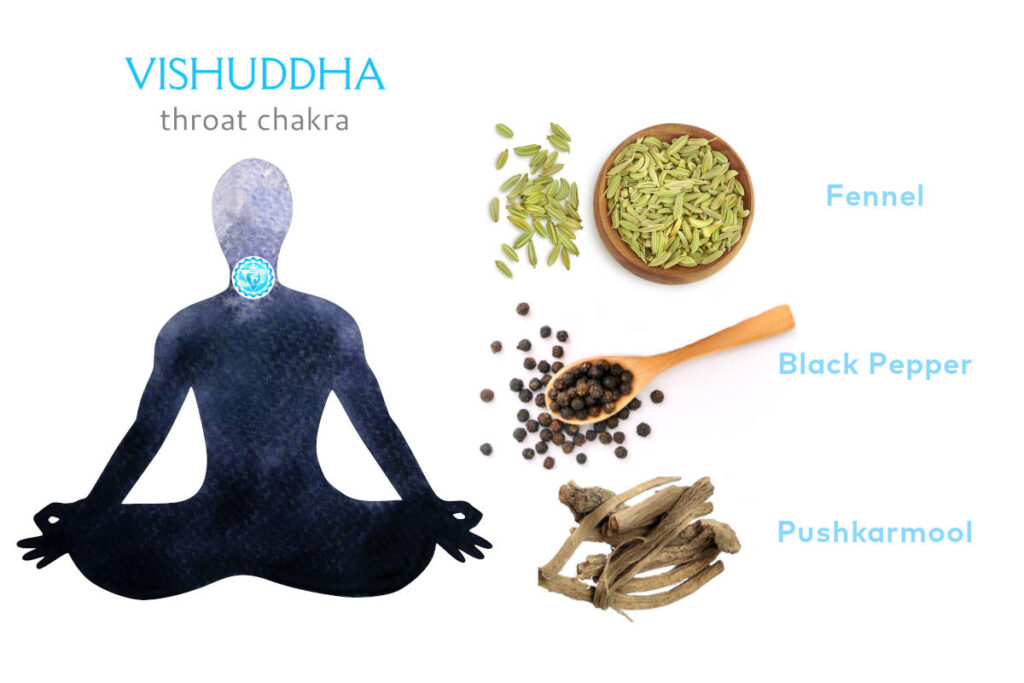
Qualities of the throat chakra
- Fifth chakra: Throat chakra
- Sanskrit Name: Vishuddha
- Location: Midpoint of the neck
- Color: Blue
- Herbs: Fennel, black pepper, pushkarmool, slippery elm
- Element: Ether
- Yoga pose: Matsyasana (Fish Pose)
- Lifestyle tip: Breathing exercises, neck stretches, working with blue stones like lapis lazuli, keeping good posture.
- Spiritual meaning: Vishuddha is all about being heard and expressing yourself openly – connecting with your true inner voice and allowing it to shine out into the world. Your deepest dreams, ideas and truths have power to elevate and transform the world.
- Signs of imbalance: Fear of speaking your mind, throat discomfort, thyroid imbalance, partaking in gossip, hearing difficulties.
Top 3 herbs for the throat chakra
Two spices and one special high altitude root make for the perfect remedy for a thwarted throat chakra. Break through all that holds you back from expressing your truth with these herbs.
Fennel for throat chakra
A blocked throat chakra may create thyroid issues, which can cause fatigue, mental fog, irregular body temperature, swelling around the neck and more. Fennel seeds are a powerful spice that help support already healthy thyroid levels for regular function, resulting in a clearer and more energized mind that can articulate thoughts and ideas.
How to use:
Try Fennel tea to soothe the throat center and modulate immune function any time of day — stir in honey for added support.*
Black Pepper for throat chakra
If often when you try to speak you have to clear your throat or find it difficult to amplify your voice, or in general have a scratchy throat (or perhaps you are shy to speak) your 5th chakra may be blocked. Luckily, trusty black pepper is a natural expectorant that can help remove excess mucus so you can speak, sing, share and express without barrier or feelings of embarrassment.
How to use
Add extra black pepper to soups and other hot foods, or try Turmeric Formula, featuring Black Pepper, which can comfort the throat and clear the respiratory tract.*
Pushkarmool for throat chakra
Maximize your lung’s capacity with this amazing high elevation root that’s been used for millennia in the Himalayas for respiratory support. Feelings of stress, social anxiety, timidity – or even the opposite end of the spectrum, over-talking and gossip – are signs of throat chakra imbalance. Pushkarmool can help aid healthy respiratory function so you can practice deep breathing exercises to slow the mind, relax your thoughts and allow for better communication in all areas of life.
How to use
The benefits of Pushkarmool can be embraced in tea, powder and supplement form.
Herbs for the Third Eye Chakra
The third eye chakra is a spiritual epicenter connected to intuition, perception, consciousness, creativity and expansion. Meditating with awareness at the third eye is a common practice that profoundly deepens one’s spiritual journey. There are two herbs and one spice that especially complement third eye practices to nurture your awakening: Tulsi, Shankhpushpi (morning glory) and Cardamom.
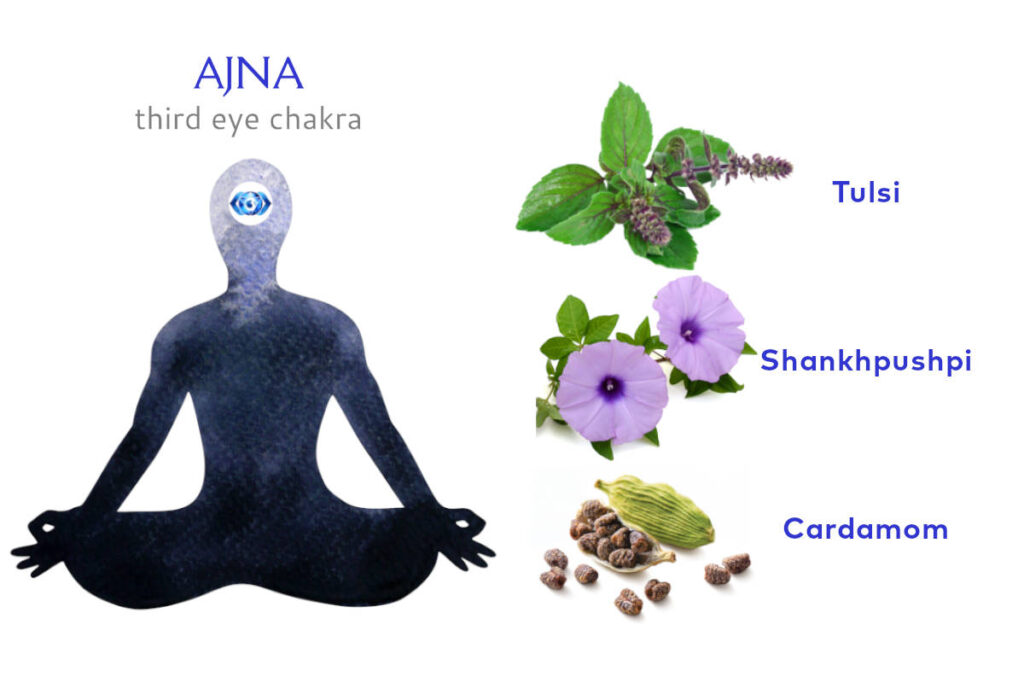
Qualities of the third eye chakra
- Fifth chakra: Third eye chakra
- Sanskrit Name: Ajna
- Location: Between the eyebrows
- Color: Indigo
- Herbs: Tulsi, Shankhpushpi, Cardamom, Passionflower
- Element: Light
- Yoga pose: Baddha Virabhadrasana (Humble Warrior)
- Lifestyle tip: Third eye meditation, light visualization, intuitive movement, colorful whole food diet, lavender essential oil
- Spiritual meaning: The third eye is associated with spiritual perception and the infinite nature of consciousness. It is linked to sacred visions, clairvoyance, and intuition in life and relationships.
- Signs of imbalance: Narrow mindedness, disconnect from your intuition, confusion, feeling of being stuck in life, fear of the future, resistance to healthy change.
Top 3 herbs for the third eye chakra
These herbs have been used for millennia to aid in meditation, spiritual growth, and deepening one’s intuition and creativity. One of them is the queen of herbs, the other the queen of spices, and the third a bringer of good fortune.
Tulsi for third eye chakra
One sign of a blocked third eye center can be feelings of sadness, anger, moodiness, frustration and disconnect from one’s intuition. Tulsi – that treasured queen of herbs – is known to uplift mood, relieve pent up tension, and lift one to their highest path and calling. This herb has actually been referred to as “liquid yoga” for its spiritual benefits that deepen awareness and make the mind flexible and open a world of possibility.
How to use:
To really savor the benefits, sip on Tulsi tea for energetic and spiritual uplift. You can enjoy it on its own or paired with other herbs for synergistic benefits. For a quick, convenient boost, you can also use a whole, organic tulsi supplement.*
Cardamom for third eye chakra
Cardamom is the hailed queen of spices. An indication of a blocked 6th chakra is being stuck in the past or worried about the future. Luckily, this vibrant, aromatic seed helps bring you right back into the moment. It roots you into the “here” and “now” to appreciate all that is happening and unfolding for you. Once grounded back with its herbal, citrusy warmth, you can better open the third eye and move deeper into your inner light.
How to use
First off, you can purchase either whole cardamom seeds or powdered cardamom to incorporate generously into your cooking (if whole seeds, remove before serving). Or, you can find cardamom in a variety of spiced tea blends like Tulsi Masala Chai and Tulsi Turmeric Chai.*
Shankhpushpi for third eye chakra
Whether you’re a lifelong artist, a poet since birth or an aspiring creative, you seek inspiration internally and externally. When the third eye is blocked, it can be very difficult to access your creative lifeforce, which can cause disconnect from your intrinsic gifts and talents. Shankhpushpi, the bringer of good fortune, is the herb for you. This herb is known to cleanse your spiritual energy field, and bring a wellspring of fresh, positive vibrations and deep otherworldly insights, which you can receive and manifest in your art; whatever form it takes.
How to use
The creativity benefits of Shankhpushpi can be enjoyed in an herbal formula, like our Joy supplement.*
Herbs for the Crown Chakra
The crown chakra is correlated with pure connection with the divine and represents both universal and spiritual consciousness. It is the center of self-realization and ascension from the physical to the cosmic being. The crown chakra, in Sanskrit, is called Sahasrara, which translates to thousand-petaled – and there are indeed both petals and leaves, like blue lotus, bacopa and gotu kola that can aid this sacred journey to enlightenment.
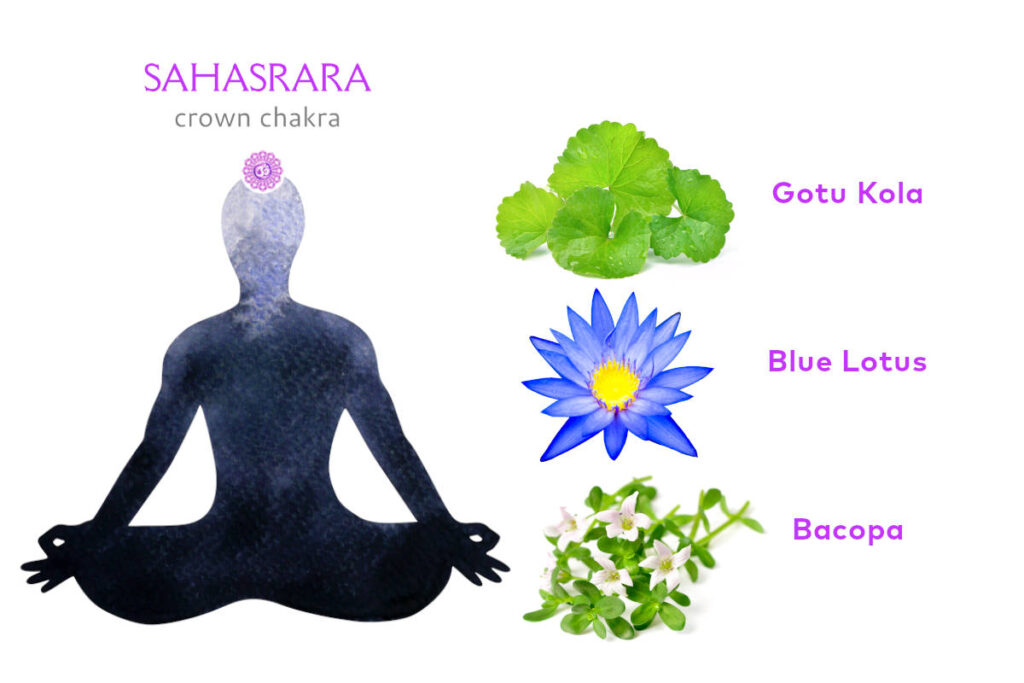
Qualities of the crown chakra
- Fifth chakra: Crown chakra
- Sanskrit Name: Sahasrara
- Location: Crown of the head
- Color: Violet
- Herbs: Gotu kola, blue lotus, bacopa, lavender
- Element: Thought
- Yoga pose: Padmasana (Lotus pose)
- Lifestyle tip: Quietude, creating gratitude lists, stargazing, crown chakra meditation, connecting with the sights and sounds in nature.
- Spiritual meaning: The crown chakra is considered the gateway to the divine, where one can connect directly with source energy. It is all about spiritual connection to the supreme, transformation and embodiment of divinity.
- Signs of imbalance: Confusion, lack of focus, feeling of disconnect, stress, exhaustion, difficulty sleeping, lack of empathy, feelings of superiority.
Top 3 herbs for the crown chakra
To clear the way to the divine energy of the crown chakra, powerful nootropics like bacopa, blue lotus and gotu kola are the ultimate guides from the plant world. Each of these herbs have a distinct ability to support cognitive health so one may move beyond the mental noise into their true, vibrant, illuminated higher self.
Gotu Kola for crown chakra
Confusion and mental fog are two of the manifestations of an imbalanced crown chakra. Luckily, Gotu Kola, also known as the “herb of longevity,” has long been used in ancient Chinese and Ayurvedic systems for these very issues. Gotu Kola works to bring about cognitive clarity and mental acuity. This helps remove the distractions that often get between you and your spiritual aspirations. It also aids in meditative practice, nurturing your ability to attain single pointed loving awareness on source energy.
How to use:
The benefits of gotu kola can be conveniently enjoyed any time of day via a whole herb supplement. The tea is a lovely complement to meditation and yoga practices.*
Blue Lotus for crown chakra
A blocked crown chakra can result in a sense of disconnect from the divine. The beautiful flower, leaf and fruit of blue lotus is known to help facilitate divine and spiritual experiences. This mystical water lily is believed to bring about clearer spiritual vision, vivify the dream world and lucid dreaming, and open a fluid pathway for those seeking enlightenment. The transcendent qualities of blue lotus allow for balancing of the crown chakra, while heightening intuition and even eliciting very mild psychoactive effects for expanded consciousness.
How to use
Blue lotus can be found in extracts, tinctures and infusions, and may be conveniently consumed in supplements as well.
Bacopa for crown chakra
Feeling distressed, hectic and overwhelmed can all result when the 7th chakra is blocked. Bacopa, also known as Brahmi, can help calm the storm. This rasayana herb is considered the herb of grace and rejuvenator of the intellect. Not only can it help you restore your sense of inner peace, it can also help you reclaim the power of your mind. When overbearing thoughts and emotions are released, it allows for access to the intrinsic relaxation, brilliance, wisdom and illumination that the crown chakra beholds.
How to use
The benefits of bacopa are best enjoyed in the morning, in either a whole herb supplement, like these organic Memory capsules; or this energizing Tulsi Breakfast Tea.*
*These statements are not meant to diagnose or treat any disease or health issue. For treatment and medical advice, please consult your physician.
Complement your chakra opening practices with this home pranayama meditation for stress relief.
